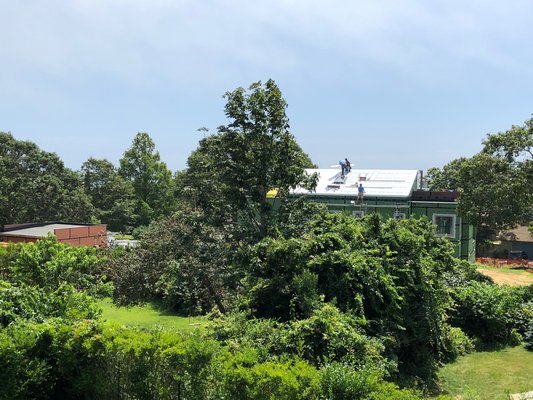
A Montauk homeowner has taken the East Hampton Town Building Department to task over its issuance of a building permit to a neighbor for what he describes as a third story on a house—that happens to be smack in the middle of his line of sight to the ocean.
The house built last year at 10 Hudson Road, in Hither Hills, is not unlike most other modern designs in the sloping neighborhoods where each house gazes out to the Atlantic over the top of the one downhill from it: It has a flat roof, which can double as a lofty deck space where owners and guests will be able to lounge with the ocean as a backdrop.
But in the center of its flat expanse, the house also has a 30-foot-wide, nearly 8-foot-tall, gabled structure with glass doors that face seaward. The owner, Michael Gengos, and his representatives say the structure—they are calling it an “attic”—is merely a shelter for the home’s HVAC units and the staircase the climbs to the roof from the interior of the house.
“It’s not habitable space,” Mr. Gengos’ attorney David Gilmartin said. “Habitable space has certain requirements with respect to size and this attic does not have the size required to come to the conclusion that this is habitable space. It’s storage for mechanicals and the roof deck.”
But a neighbor, Joseph Stavola, whose house sits just uphill of the Gengos property, says that the addition of the structure constitutes a third story of living space and violates town height limits. He says the space, while also acting as a shelter for mechanical equipment, is clearly meant to be used as living space, be it for additional seating under the roof or to host a rooftop bar area. He has asked the East Hampton Town Zoning Board of Appeals to throw out the building permit issued in 2017 for the house and consider whether the plans conform to town building codes.
“I don’t see how someone can build something 30 feet wide and 8 feet high and that’s not a third story,” Mr. Stavola said recently. “The building department isn’t saying anything to us. They are leaving it up to the ZBA. But why do I have to police the building department’s work? I’m not paid to do their job.”
Town code bars any third-floor living space and limits the height of flat-roofed homes to 25 feet, and gabled roofs to 30 feet.
Mr. Stavola says there is no discussion in the code about whether a flat-roofed home can have a gabled structure atop it also, or if that would mean the gabled roof height limit should then be applied.
But before the ZBA can get into whether or not the permit was issued improperly or not, it must consider whether Mr. Stavola’s objections were raised in time. State law allows just 60 days from the time that another person might “reasonably have been aware” of the issuance of a building permit, for objections to be raised.
Mr. Stavola says that the rooftop addition was constructed in late June of last year and that he hired an attorney and filed his objections in mid-August. Before the “attic” was actually built, he said, it’s true nature was not evident.
“Before that, there was no way to tell what it was,” he said. “It looked like it was a lean-to covering some equipment until the windows and doors went in.”
Mr. Gilmartin says that he would think Mr. Stavola should reasonably be expected to have become aware of the project’s details in November 2017 when the previous house on the property was demolished. But certainly the clock should have started ticking on the 60-day limit to raise an objection when Mr. Stavola’s father, Dan Stavola, visited the construction site in March of last year, according to Mr. Gilmartin.
“He had an obligation at that point to go and see the building permit and see if there was anything he would object to,” Mr. Gilmartin said. “The idea that the time starts when he says he noticed something that he thought was improper is just completely arbitrary.”
The ZBA is expected to again discuss Mr. Stavola’s objections to the Gengos house at its March 19 meeting.